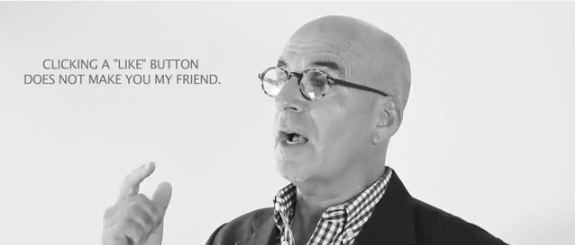Ted Rubin and I “met” back in 2010 via social media and Ted’s extraordinary personality and commitment to establishing and maintaining connections is what has made him who he is today. His “Return on Relationship” theory of engaging in a more personal way in ALL aspects of our lives has become one influential message that is quickly becoming a beloved belief. Ted’s amazing ability to connect and influence is well-deserved and I appreciate his time with me in answering some questions for Simple Bliss Mag.
JustBeNice
Is There a One-Size-Fits-All “Giving” Ratio? ~via @InsideCXM
Any time a big digital idea comes along, especially an idea that shakes free from the status quo, the marketing masses have one simple question – how does it work? If that question can’t be answered with reams of data, the concept is often dismissed. It’s a pragmatic set-up that often works, but also risks missing the type of very important outlier that doesn’t lend itself to conventional metrics and analytics.
So, what’s this got to do with Return on Relationship (ROR, #RonR) and giving? Well, you may be wondering if there’s a perfect, one-size-fits-all giving ratio that’s sure to check off the requisite statistical boxes and deliver the desired results. It’s a natural thing to wonder in this industry, but it’s not as easy to measure as page-views, followers or shares.
Whereas an ad campaign can be broken down and measured in parts, giving is a more holistic endeavor. You can certainly measure the results of giving and gain insight into its positive effects on your bottom line, but there’s no magic number for the process. In fact, trying to determine exactly how much needs to be given ultimately undermines the intent of the process. Giving isn’t about instant gratification. It’s about long-term success.
Think about some of the mom-and-pop businesses in your hometown. Which ones are still there? What makes one convenience store, restaurant or small retail outlet survive and thrive, when similar business located in the same area fail? Prices, product quality and location all matter, but relationships are what truly separate the long-term success stories from the failures.
In the case of a small business, those relationships were, and often still are, built the old-fashioned way. That means talking to people face-to-face, getting to know them on a personal level, and remembering their name the next time they stop in to visit. It means addressing customer concerns in a prompt, respectful manner and guiding customers through purchases with a mutually beneficial end in mind. It’s about establishing relationships in a way that doesn’t lend itself to predetermined ratios.
Does that mean you need to operate a large corporation like it’s the general store on “The Waltons?” Of course not. Big data still has a prominent seat at the table, just not at the expense of recognizing that those data points represent living, breathing people.
Technology is often blamed for the impersonal nature of the modern business-consumer relationship. It shouldn’t be. The most powerful relationship-building tools in the world are hiding right in plain sight on our smartphones, tablets and laptops. The power of those tools is determined by how we use them.
Take social media, for example. One plan of attack is to get as many followers as possible, bombard them with carefully selected marketing content, ignore comment threads on posted content, rinse and repeat. To me, that looks a lot more like sending someone a catalog than it does building a meaningful relationship.
To get the most out of giving, we need to focus more on the “social” part and less on the “media” part. Have an active presence and use social media to genuinely interact on a personal basis. It’s an opportunity to build real relationships with customers based on timeless values, and in a far more efficient manner than simply waiting for those customers to wander into your brick-and-mortar establishment.
Is there a perfect ratio for giving? No, but that’s the point. So give, #JustBeNice, and don’t expect anything in return. After that, prepare to be amazed when what you get in return is far better than what you’d have expected in the first place.
Originally posted at InsideCXM JUNE 2, 2014 BY
Simplicity—What’s Your Definition?
I recently read a blog post by Margaret Molloy, CMO of Siegel+Gale about her favorite quotes on “simplicity,” and the first sentence resonated with me:
“At Siegel+Gale, we often think of simplicity as creating brand experiences that are remarkably clear and unexpectedly fresh.”
I think that should be the mantra for any business, really—to create clear, fresh experiences for our customers—something so pure that it feels as delightful as plunging into a crystal clear pool on a hot day. If every organization focused on this, can you imagine the power it would create?
It’s funny that while we as humans crave simplicity, we also tend to get very busy making everything complicated. Why is that? What can we do to counter it? When I talk about #JustBeNice or #RonR, simplicity is the root. It’s the very core of true connection… yet it’s one of the hardest things to maintain.
Rhythm is another word that brings the feeling of simplicity to mind. It’s great when we experience it or watch it happen, but boy is it hard to keep up!
Stop worrying about what’s next, for a moment, and concentrate on defining what simplicity means to you… and how to make it part of your “Brand DNA.”


